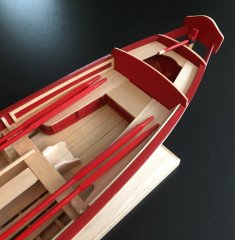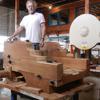-
Posts
3,349 -
Joined
-
Last visited
Reputation Activity
-
 Cathead got a reaction from Tigersteve in 18th Century Longboat by Tigersteve - FINISHED - Model Shipways
Cathead got a reaction from Tigersteve in 18th Century Longboat by Tigersteve - FINISHED - Model Shipways
Looks very crisp.
-
 Cathead got a reaction from Nirvana in 18th Century Longboat by Nirvana - FINISHED - Model Shipways - 1:48
Cathead got a reaction from Nirvana in 18th Century Longboat by Nirvana - FINISHED - Model Shipways - 1:48
I, too, think the brass is preferable, given that it's a closer match to the common yellowish tones of the boat as you've built it. If I were to use the same material for my boat, which is in a white and black color scheme, I'd probably go with blackened, once again to best match the color overall.
-
 Cathead got a reaction from Julie Mo in Charles W Morgan by Brucealanevans - FINISHED - Model Shipways
Cathead got a reaction from Julie Mo in Charles W Morgan by Brucealanevans - FINISHED - Model Shipways
How frustrating. I've certainly found that a clear head, after taking a break, can come up with a solution more easily than a frustrated head. Good luck.
-
 Cathead reacted to Brucealanevans in Charles W Morgan by Brucealanevans - FINISHED - Model Shipways
Cathead reacted to Brucealanevans in Charles W Morgan by Brucealanevans - FINISHED - Model Shipways
Finished hoisting the Main Topgallant yard (sail furled) and all the attendant running rigging except for the braces.
Now I put the ship up and away, and begin working on the foremast yards. Hopefully the experience of the main yards and the trouble spots due to not recognizing things best done before anything is mounted will stand me in good stead, as this will be essentially a repeat of the mainmast yards. I will repeat the same mixture of set and furled sails on the foremast.
For simplicity sake and my sanity, I have not set/rigged for the staysails. Apparently the main staysails were often not set, but I probably should have set the mizzen staysails - will, however, leave well enough alone.
Learning a lot, and rigging my next full ship - likely Grenado - will hopefully benefit from the experience.
-
 Cathead got a reaction from Elijah in Benjamin W Latham by mattsayers148 - Model Shipways 2109 - 1:48
Cathead got a reaction from Elijah in Benjamin W Latham by mattsayers148 - Model Shipways 2109 - 1:48
If you're fitting a rod and ring to that beam, is it going to be some kind of pivot? Are you essentially making a bearing? I can't figure out what for, though, and could be way off. Hey, you said guess.
-
 Cathead got a reaction from ggrieco in USRC Ranger 1819 by Cathead – FINISHED – Corel – Scale 1:64
Cathead got a reaction from ggrieco in USRC Ranger 1819 by Cathead – FINISHED – Corel – Scale 1:64
Well, good thing I ordered both blocks and line from Syren today! I had recalled the same experience from the two MS boat kits I've done and decided to spend my credit there on other stuff. Thanks for the feedback, sir.
-
 Cathead got a reaction from ggrieco in USRC Ranger 1819 by Cathead – FINISHED – Corel – Scale 1:64
Cathead got a reaction from ggrieco in USRC Ranger 1819 by Cathead – FINISHED – Corel – Scale 1:64
Well, no worries, I've done my orders and now eagerly await better stuff to work with. In the meantime I have a busy work week and a spousal birthday on Saturday, so not much will likely get done soon anyway.
-
 Cathead got a reaction from ggrieco in USRC Ranger 1819 by Cathead – FINISHED – Corel – Scale 1:64
Cathead got a reaction from ggrieco in USRC Ranger 1819 by Cathead – FINISHED – Corel – Scale 1:64
Thanks to both of you. It's too bad I already did the deck blocks, but I also tended to choose the best of the lot for that job, so even after re-inspection I think they'll serve. Or I suppose I could cut 'em off and try my hand at attaching new ones straight to the rings. Hmmm. Anyway, it's the support network and the presence of actual builders/sellers like Chuck and other small businesses on here that make this such a great place (and yes, my membership in NRG is up-to-date so I'm not just saying that!).
While I wait for all this new stuff, I'll probably work on shaping the masts and rebuilding the cross-trees from scratch (another crappy metal piece I've given up on, and they should be wood anyway).
Matt, is M-E's rigging line any good? I ask because I have an unused credit there and budget is always a concern for me. I'm definitely ordering blocks from Syren.
-
 Cathead got a reaction from Larry Cowden in USRC Ranger 1819 by Cathead – FINISHED – Corel – Scale 1:64
Cathead got a reaction from Larry Cowden in USRC Ranger 1819 by Cathead – FINISHED – Corel – Scale 1:64
Well, would you look at that, now. I'd been all over the site but never thought to click on the actual blocks. Thank you, sir. Do you have an alert set up for your name or something? I thought of pming you but didn't want to waste your time with such a newbie question. An order will be forthcoming.
-
 Cathead got a reaction from ggrieco in USRC Ranger 1819 by Cathead – FINISHED – Corel – Scale 1:64
Cathead got a reaction from ggrieco in USRC Ranger 1819 by Cathead – FINISHED – Corel – Scale 1:64
I'm facing a challenge, which I hope one of you more experienced sorts can advise me on.
This kit has finally broken my desire to stick with the supplied materials. Both the blocks and belaying pins are near worthless, and the rigging line seems cheap. So I've decided to bite the bullet and order better stuff from Syren or an equivalent quality provider. But here's my dilemma: I don't know what size rigging line to order. Nowhere in the Corel instructions can I find a listing of the three line thicknesses they provide. And what really makes me paranoid is, I don't know how large the holes are in, say, the Syren blocks. So how do I determine what size line to buy, so that it's right and fits through good blocks? Any suggestions?
I found the line-size chart on Syren's website, which is nice, but it doesn't help me determine what will fit properly in different blocks. Help a newbie, please!
-
 Cathead got a reaction from FriedClams in 19th Century 31-ton Revenue Cutter by CharlieZardoz - Scale 1/64 - building as USRC Active based off Doughty plans and BlueJacket Shipcrafters kit
Cathead got a reaction from FriedClams in 19th Century 31-ton Revenue Cutter by CharlieZardoz - Scale 1/64 - building as USRC Active based off Doughty plans and BlueJacket Shipcrafters kit
The yellow stripe is very British; were American ships ever painted following that pattern? It looks nice but I wonder if it's at all authentic?
Really nice rundown of color options and models.
-
 Cathead reacted to Ol' Pine Tar in Fair American by Pine Tar – Model Shipways – 1:48
Cathead reacted to Ol' Pine Tar in Fair American by Pine Tar – Model Shipways – 1:48
Thanks Don. The gallows, bits and binnacle are wood. Gallows are from the kit and the bits and binnacle scratchbuilt. The capstan and anchors are kit castings. I'll probably replace several of the castings with scratchbuilt stuff.
-
 Cathead reacted to Ol' Pine Tar in Fair American by Pine Tar – Model Shipways – 1:48
Cathead reacted to Ol' Pine Tar in Fair American by Pine Tar – Model Shipways – 1:48
Thanks for the comments and likes! Still contemplating a rebuild of the hull. Meanwhile...
Cleaned up some of the castings and laser cut pieces,and built a couple of smaller items.
-
 Cathead reacted to Panama Port in Mississippi by Panama Port - OcCre - 1:80
Cathead reacted to Panama Port in Mississippi by Panama Port - OcCre - 1:80
Finally a little progress. I ended jumping around as I didn't have the proper paint. Most of the furniture for the main deck interior is painted. I have a few odds and sods to clean up and I should be able to start on the second deck.
-
 Cathead got a reaction from mtaylor in USRC Ranger 1819 by Cathead – FINISHED – Corel – Scale 1:64
Cathead got a reaction from mtaylor in USRC Ranger 1819 by Cathead – FINISHED – Corel – Scale 1:64
Well, good thing I ordered both blocks and line from Syren today! I had recalled the same experience from the two MS boat kits I've done and decided to spend my credit there on other stuff. Thanks for the feedback, sir.
-
 Cathead got a reaction from mattsayers148 in USRC Ranger 1819 by Cathead – FINISHED – Corel – Scale 1:64
Cathead got a reaction from mattsayers148 in USRC Ranger 1819 by Cathead – FINISHED – Corel – Scale 1:64
Well, good thing I ordered both blocks and line from Syren today! I had recalled the same experience from the two MS boat kits I've done and decided to spend my credit there on other stuff. Thanks for the feedback, sir.
-
 Cathead got a reaction from mtaylor in Benjamin W Latham by mattsayers148 - Model Shipways 2109 - 1:48
Cathead got a reaction from mtaylor in Benjamin W Latham by mattsayers148 - Model Shipways 2109 - 1:48
If you're fitting a rod and ring to that beam, is it going to be some kind of pivot? Are you essentially making a bearing? I can't figure out what for, though, and could be way off. Hey, you said guess.
-
 Cathead got a reaction from Canute in USRC Ranger 1819 by Cathead – FINISHED – Corel – Scale 1:64
Cathead got a reaction from Canute in USRC Ranger 1819 by Cathead – FINISHED – Corel – Scale 1:64
Well, good thing I ordered both blocks and line from Syren today! I had recalled the same experience from the two MS boat kits I've done and decided to spend my credit there on other stuff. Thanks for the feedback, sir.
-
 Cathead reacted to mtaylor in Licorne 1755 by mtaylor - 3/16" scale - French Frigate - from Hahn plans - Version 2.0 - TERMINATED
Cathead reacted to mtaylor in Licorne 1755 by mtaylor - 3/16" scale - French Frigate - from Hahn plans - Version 2.0 - TERMINATED
Thanks for the "likes", the comments, and the discussion.
Things have been running, shall we say, dead dog slow here lately in the shipyard. I'm putting the hours in but seems like nothing gets finished. Probably normal then at this stage.
The center line furniture aft of the main mast is done except for the pantry which is on hold. No point in blocking access at this point. Also the two crew ladderways forward of the main mast are done. The pic shows the capstan but it's only set into place at this point so it doesn't get misplaced or damaged. The crossbeam for the pinrail forward of the main mast has been safely tucked away so it doesn't get damaged. I'm moving forward on the deck to the remaining hatchways. After the planking the rest of the deck and doing the ceiling, I'll install what I have ready and make the pumps (do over!!!) and the fireplaces.
Part of the bog that's slowing things down is taking measurements for the planking and transferring them to the drawings I'm making for the laser.
I do find myself being happier with my output as I think I'm getting better at joinery and even more patient with fitting things than I was before. After a couple of "by your leave, sir" hassles, I found I need to measure 3 times before transferring any measurement to the wood. A bit of confidence here and there goes a long ways.
Here's the pic and as always, comments, critiques, and discussion are welcome.
-
 Cathead reacted to CaptainSteve in USRC Ranger 1819 by Cathead – FINISHED – Corel – Scale 1:64
Cathead reacted to CaptainSteve in USRC Ranger 1819 by Cathead – FINISHED – Corel – Scale 1:64
CH, I wasn't at all impressed with the ME line in the Bounty Launch kit, and replaced all of it with Chuck's Syren rope. I plan on doing the same with my MS Constitution build, and have already laid in one order with Chuck for both rope and blocks.
I think you will notice a vast difference with the Syren stuff.
-
 Cathead got a reaction from mtaylor in USRC Ranger 1819 by Cathead – FINISHED – Corel – Scale 1:64
Cathead got a reaction from mtaylor in USRC Ranger 1819 by Cathead – FINISHED – Corel – Scale 1:64
Well, no worries, I've done my orders and now eagerly await better stuff to work with. In the meantime I have a busy work week and a spousal birthday on Saturday, so not much will likely get done soon anyway.
-
 Cathead got a reaction from CaptainSteve in USRC Ranger 1819 by Cathead – FINISHED – Corel – Scale 1:64
Cathead got a reaction from CaptainSteve in USRC Ranger 1819 by Cathead – FINISHED – Corel – Scale 1:64
Well, no worries, I've done my orders and now eagerly await better stuff to work with. In the meantime I have a busy work week and a spousal birthday on Saturday, so not much will likely get done soon anyway.
-
 Cathead got a reaction from dgbot in Benjamin W Latham by mattsayers148 - Model Shipways 2109 - 1:48
Cathead got a reaction from dgbot in Benjamin W Latham by mattsayers148 - Model Shipways 2109 - 1:48
If you're fitting a rod and ring to that beam, is it going to be some kind of pivot? Are you essentially making a bearing? I can't figure out what for, though, and could be way off. Hey, you said guess.
-
 Cathead got a reaction from mattsayers148 in USRC Ranger 1819 by Cathead – FINISHED – Corel – Scale 1:64
Cathead got a reaction from mattsayers148 in USRC Ranger 1819 by Cathead – FINISHED – Corel – Scale 1:64
Well, no worries, I've done my orders and now eagerly await better stuff to work with. In the meantime I have a busy work week and a spousal birthday on Saturday, so not much will likely get done soon anyway.
-
 Cathead got a reaction from mtaylor in USRC Ranger 1819 by Cathead – FINISHED – Corel – Scale 1:64
Cathead got a reaction from mtaylor in USRC Ranger 1819 by Cathead – FINISHED – Corel – Scale 1:64
Thanks to both of you. It's too bad I already did the deck blocks, but I also tended to choose the best of the lot for that job, so even after re-inspection I think they'll serve. Or I suppose I could cut 'em off and try my hand at attaching new ones straight to the rings. Hmmm. Anyway, it's the support network and the presence of actual builders/sellers like Chuck and other small businesses on here that make this such a great place (and yes, my membership in NRG is up-to-date so I'm not just saying that!).
While I wait for all this new stuff, I'll probably work on shaping the masts and rebuilding the cross-trees from scratch (another crappy metal piece I've given up on, and they should be wood anyway).
Matt, is M-E's rigging line any good? I ask because I have an unused credit there and budget is always a concern for me. I'm definitely ordering blocks from Syren.












